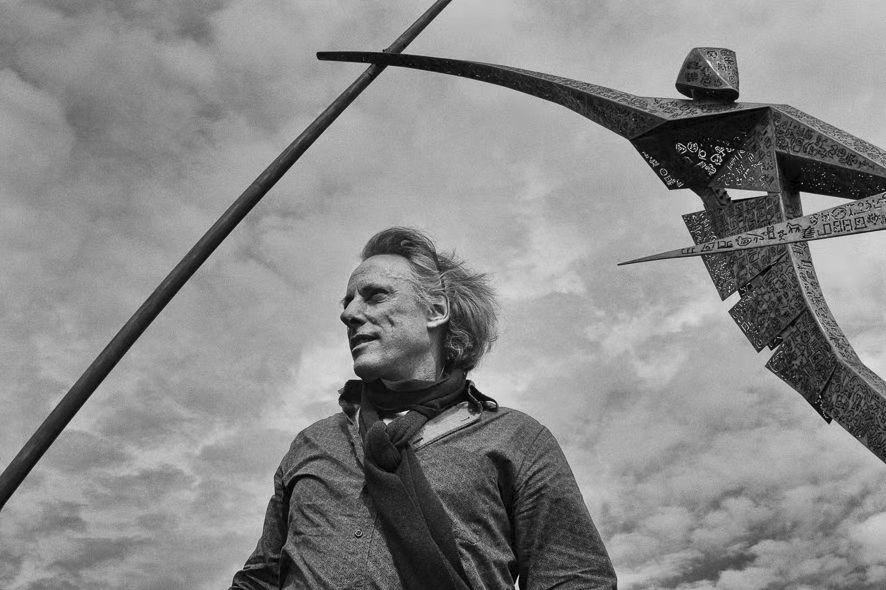人行道上的鱼循环游动,也象征着废物和废水的循环回收系统,为滇池的水和鱼类带来健康环境。清洁植物去除污染,分解有机物,恢复处理水的氧含量。这是一个将废水转化可用水的过程。滇池对水的净化使用了自动旋转增氧器,减少了有害的蓝藻。鱼的圈作品契合了用多种手法让滇池成为美丽旅游热点的想法,预示令人印象深刻的环境进步。作品“鱼的圈”由12条金眼的不锈钢鱼组成,嵌在滇池古村庄的一个空地的人行道上。回旋游动的鱼表明,一群不分主次的鱼,自发相聚;这是一个自构系统。每条鱼基于各自动机,主要是通过模仿邻近鱼的反应,导致鱼群的集体行为。社会也应该这样运转,每个人都有责任感知周围人的环境意识,并采取相应的行动。一个干净的环境始于我们自己努力关爱自然,就像我们关爱自己一样。
The artwork consists of 12 stainless steel fishes with golden eyes, embedded in the pavement of an open spot in the ancient village at Dianchi Lake. The circular swimming fishes show that a school of fish doesn’t have a leader, but it comes together on their own; it’s a self-organized system. The individual fish makes decisions based on internal motivation, but mainly by imitation of the responses of the neighbouring fish, causing the collective behaviour of the school. Society should also work like that because it is our individual responsibility to copy the environmental awareness from the people around us and act accordingly. A clean environment starts with our own individual efforts to take care of nature’s health same as we take care of our own health.
With their circular swimming the fishes in the pavement also symbolize the circular system of recycling waste and wastewater thus bringing environmental health for water and fishes in Dianchi lake by other means. Cleaning plants remove solids and pollutants, break down organic matter and restore the oxygen content of treated water. This is a process of converting wastewater – water that is no longer needed or is no longer suitable for use – into bilge water that can be discharged back into the environment by the use of rotation. The cleanup of the water of Dianchi Lake also shows the water circulation by automatic rotators which adds oxygen to the water, thus diminishing the growth of blue algae that endanger people’s health. All in one the artwork of circular swimming fish as shown as a roundabout on the street feeds the thought that there are several roads which can be chosen to make Dianchi Lake a beautiful touristic hotspot where the various efforts and their results are bundled in an impressive environmental progress.

Hans Mes生于1950年,出生地为荷兰Utrecht, 1973-1979 进修于Groningen, Minerva Academy Of Arts,毕业后获得雕塑设计和纪念碑设计双学位。他的作品除了包含了纪念碑的大型雕塑项目外,还包括了一些小的雕塑、浮雕、肖像和纪念章的创作。
Hans 通常从收集与雕塑地点有关地信息开始他的创意。之后他会把用数码科技模拟好的作品附加在放置地点的图片上。这样他可以从不同的角度去观察地点周边环境和其作品地塔配性,除去塔配性,融合性和空间性同时也是他考察作品的表现力的标准之一。
在这些程序之后,Hans才会考虑用料以及技术。用料和技术都必须最好地描述作品地精要。又此设计方法导致,除青铜和石头之外,他还使用水,铁,木和黄铜。Hans的工作室适应于许多不同地技术和工艺的创作,其中包括一个黄铜铸造间。在此工作室中,他全职忙于世界各地所向定做的艺术作品,而他的这些作品可谓隐性视觉艺术的标志。
Hans Mes (born in Utrecht, 1950) studied at the Groningen Academy of Arts ('Minerva') from 1973 to 1979, where he graduated in two disciplines: sculpting and monumental design. His work comprises not just monumental projects, but also small sculptures, relief’s, portraits and medals.
On top of this, he writes poems and paints watercolours. Hans Mes starts his design process by gathering all the information he feels is relevant to the place where the sculpture is to be placed. He captures the intended location and digitally projects the sculpture onto the images of this location. This allows him to view the sculpture in its specific surroundings from all angles. He also assesses the expressiveness of intrinsic and spatial aspects.
Only then does he determine which materials and techniques will best capture the essence of the design. Because of this approach, he does not only make bronze and/or stone sculptures but he also uses copper, wood, steel and water. His workshop is geared to a lot of different techniques and includes a bronze foundry; here he works full time on commissioned works of art worldwide. By carrying out each work of art personally, Mes emphasises that technical shaping the properties of materials involved is the sculptor’s spatial handwriting to create meaning by sculpture. Hans Mes himself characterizes his art as visible symbols of things invisible.